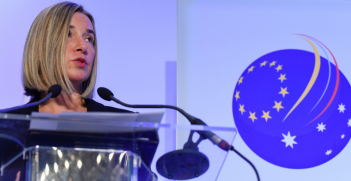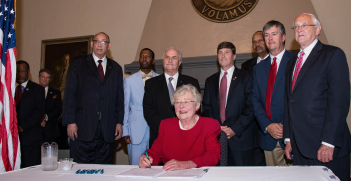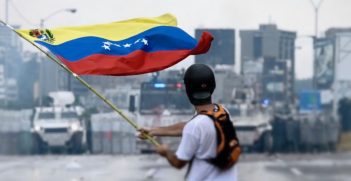Singapore's Almost-Election

The ascendance of Halimah Yacob last year to the Singaporean presidency is the latest in a long line of efficient and rather drab transfers of power. In a democracy however, efficiency often sits uneasily beside true representation.
Singaporeans were supposed to go to the polls on 23 September 2017 to elect the country’s eighth president but the contest never happened, as the only name on the ballot was Halimah Yacob, endorsed by the ruling People’s Action Party (PAP). Four other prospective candidates failed to secure eligibility certificates from a government-appointed Presidential Elections Committee. Thus, Halimah Yacob was the declared winner and become Singapore’s first female president.
However, tension between political control and competition inherent to the design of the elected president has long rendered it controversial. Yet this time around, control triumphed so emphatically that it decisively undermined whatever semblance of credibility remained with the institution. Halimah thus enters the position with no more political authority than if she were simply appointed by the government.
Yet the PAP was just as concerned about pre-empting a possible rogue president, lest participation got out of hand. In effect, the post was tailor-made for the PAP establishment. Not surprisingly, Singapore has only witnessed two contested elections: in 1993 and 2011. Nevertheless, things have not always gone quite to plan. This carefully crafted institution has generated unintended consequences.
Departing from the script
The first election in 1993 was a drab and bizarre affair. The PAP-endorsed former secretary general of the PAP-affiliated National Trades Union Congress and deputy prime minister, Ong Teng Cheong, prevailed. Yet his opponent, the former accountant general, Chua Kim Yeow, attracted 41.31 per cent of the vote. Evidently, some voters simply wanted to support a candidate who was not PAP-endorsed.
However, Ong proved in office to be more serious about his custodial role than was expected or appreciated by the authorities. Indeed, he exposed and challenged a fundamental absence of transparency necessary for his role and requested relevant information from the government. Ong did eventually receive information, but regarded it as incomplete.
The 2011 election was also a surprise for the ruling party. Four candidates contested. The PAP-endorsed former deputy prime minister, Tony Tan, won by just 0.35 per cent over a former PAP backbencher with grass-roots links, Tan Cheng Bock. Tony Tan’s mere 35.20 per cent of the vote again highlighted the appetite of many voters for candidates not endorsed by the PAP. Adding to the PAP’s concerns was the fact that Tan Jee Say—an investment advisor and former public servant who had contested the May general election that year for the opposition Singapore Democratic Party—had qualified for the presidential election and secured 25.04 per cent of the vote.
The 2011 election was also more explicitly politicised. Some candidates raised policy issues and agendas that were beyond the powers of the president. There were online campaigns, public rallies and lively debates. Such attempts to harness the elected president to a broader and more combative political contest were antithetical to the purpose behind the PAP’s shift from an exclusively ceremonial post to the elected president. It wanted a modicum of political competition among establishment figures to bestow authority to an office that could limit the powers of any non-PAP government. Much of what happened in 2011 was surplus to requirements.
Against this background, there was serious critical reflection about the elected president by the PAP, leading to a further tightening of regulations on candidate eligibility and the conduct of debate in preparation for the 2017 presidential election.
Control’s triumph and cost
In 2016, Prime Minister Lee Hsien Loong appointed a Constitutional Commission to review the elected presidency, culminating in a string of important reforms passed by Parliament late that year. These reforms combined to further shrink the pool of candidates that could qualify in 2017, and could potentially restrain a maverick president should the need arise. However, finding interested and qualified private sector Malay candidates proved especially difficult, given the disproportionate number of Malays of low socio-economic status in Singapore.
The introduction of the racially reserved election was especially controversial, attracting legal and political challenges. The PAP presented the reserved election as a far-sighted measure to try and prevent xenophobic tendencies, racism and tribalism of the sort sweeping through many Western countries.
To be sure, with 74 per cent of the population racially Chinese, the question of adequate representation of Malay, Indian and other minorities is an issue. But this does not mean that the problem is best addressed by further reifying racial categories and concepts of citizenship. The PAP’s institutions and ideologies have for many decades systematically fostered racial political consciousness. This serves to ideologically and politically fragment Singaporeans, and to militate against sustained debate about the structural foundations of, and impediments to addressing, the social and economic inequalities in Singapore affecting all races to differing degrees. The immediate effect of the reserved election was to precipitate some of the tension that the PAP was trying to avert.
One of the most fascinating avenues for this tension centred on the government claim that the reserved election and tightened eligibility criteria married two foundational PAP and Singapore values: multiculturalism and meritocracy. Many Chinese Singaporeans expressed concern about the compromising of meritocracy through de facto racial affirmative action. For its part, the PAP eschewed the very term ‘affirmative action’, instead referring to ‘interventionist’ measures that contrasted with laissez-faire approaches to race relations.
Crucially, contention over the racially reserved election was broadened and exacerbated by the fact that it prevented the racially Chinese Tan Cheng Bock from contesting. The blocking of Tan’s candidacy gave the impression that space for loyal opposition—within the PAP as much as outside it—has no more place in post-Lee Kuan Yew Singapore as during it.
Halimah Yacob thus begins her presidency without facing an election and amidst government-controlled media projections of her as fiercely independent. She is, however, a blue-ribbon PAP activist and politician who spent 33 years working for the National Trades Union Congress and subsequently served as a Minister of State and as Speaker of the House in the PAP-dominated Parliament. Her record of solid public service, and the mobilisation of support for her from the National Trades Union Congress, would have made her extremely hard to beat had an election been held. However, the experience of the 2011 presidential election so spooked the PAP and authorities that Halimah was denied this opportunity.
The restrictions placed on the elected president institution have thus undermined the very purpose it was meant to serve: affording a president political authority to potentially exercise significant discretionary veto powers. Yet Halimah has no popular mandate to act as a check on any government. Meanwhile, many Singaporeans who initially took seriously the projection of the elected president as an opportunity for popular participation have experienced new levels of frustration and become more cynical about the elected president. While government-controlled media were writing about ‘president elect’ Halimah Yacob, in social media the term ‘president select’ was widespread.
Halimah’s presidency obviates the need for another racially reserved election for the foreseeable future. But public disquiet about the reforms that produced just one qualified candidate in 2017 has sown the seeds for a different, competing reform agenda: the return to an appointed president. This was already the explicit position advanced by Sylvia Lim of the opposition Workers’ Party during debate over the latest constitutional reforms. Ironically, a measure conceived and rationalised by the PAP to curtail a non-PAP government in the event of a freak election could be feeding into greater support for the opposition. Moreover, since the global financial crisis and in its response to public concerns about inequality, the PAP has also increasingly dipped into Singapore’s reserves in new redistributive programs.
Other institutional initiatives to incorporate more Singaporeans into state-controlled political institutions have enjoyed some success. By contrast, the elected president is one initiative where the PAP may have been too clever by half. The unintended consequences of the institution have so alarmed the PAP that it has decisively reasserted political control over the elected president process.
The institution now fails to serve the PAP’s original aims of bolstering the president’s political authority. It also fails the aims of Singaporeans who sought to harness the elected president’s limited competitive elements to forms of protest against PAP power.
Professor Garry Rodan is Director of the Asia Research Centre and Professor of Politics and International Studies in the School of Business and Governance at Murdoch University.
This is an edited extract of an article that first appeared in the Australian Journal of International Affairs on 12 November 2017.





